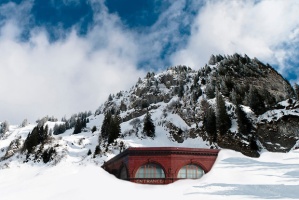We are proud to exclusively offer the Hotel Stargate for this ski season. It sits under the gaze of Papoose Mountain in the recently built hi-tech resort of Area 51, which provides challenging skiing, spectacular scenery and lively après-ski. The long, exhilarating descents from Freedom Ridge, the Time Vortex run and world class off-piste skiing will surely attract keen skiers year after year.
Essentials
- Central location – close to Groom Lake (no fishing or swimming) and a 4 minute walk to the Groom I gondola.
- ‘Small and friendly’ hotel.
- Newly renovated rooms with out of this world facilities.
- Fitness area with sauna and geo-thermal steam room (please stay away from Vaporisation area).
- Bed and breakfast basis so you can explore local restaurants, or optional upgrade to half board available.
- Free WiFi (monitored) for staying in touch with the outside world.
- Exclusive to Frozen Underground.

In Detail
The term ‘small and friendly’ was designed for places like the Hotel Stargate to make it feel more cosy. Under new ownership, this relaxed hotel has been recently converted from an unused (mostly) military base – the rooms are newly renovated and comfortable. The Stargate’s location is great too. It’s just outside the centre of Area 51 – great for a stroll around the town – and only a snowball’s throw from the dry lakeside. For getting to the lifts you have the choice of a two minute walk to the Papoose lifts, a four minute walk to the Groom I gondola for access to Freedom Ridge, or catch the ski bus right outside that can also take you over to the Roswell Hoverlifts.
Back at the Stargate there’s a bar area for evening après drinks. The hotel has its own micro-brewery with Ale-ien, Unidentified Flowing Beer and the classic Seventh Symbol on tap. Way down in the basement is a fitness area with sauna, steam room and a free juice and tea bar in the relaxation room. You’ve got the choice of sticking with bed and breakfast giving you the chance to explore Area 51’s great restaurants – alternatively get your meals sorted before you go and upgrade to half board and eat at nearby Mulder’s Spooky Bar.
Hotel
Four floors above ground and 200 below. Lifts use electro-pulsed, sub-gravitional waves (from Roswell experiments) for eco-friendly travel between floors. Level -200 requires government clearance code Purity-7 or above because of proximity to (and possible contamination from) milady radioactive exo-classified technology.
Rooms
For 2 people on a bed and breakfast basis sharing a room with Austrian twin beds, private shower and WC. Some rooms sleep up to 4 people with extra sofa bed. Above ground rooms with balcony are also available at a supplement. All bedrooms have satellite TV, hairdryer, free WiFi and are non-smoking.
Facilities
• Fitness area with geo-thermal sauna, steam room, x-ray cabin and relaxation room
• Tea and juice bar in relaxation room
• Hotel bar in breakfast room
• Free WiFi
• Ski storage room
Meals
• Hot and cold buffet breakfast
• Optional upgrade to half board with 3 course evening meals with choice of main course taken at a nearby Mulder’s Spooky Bar (approx. 5-6 minute walk)
Excursions
• Radiation walk to Area 13 and Sedan Crater
• Groom Mines Tour
• Picnic trips to the Time Vortex (when in operation)
Airport
Area 51 is served weekly from Las Vegas International Airport using our popular Janet Airways service. Or you can fly into the local airfields at Alamo, Yucca or Rachel.
Of course, the easiest way to get here is by the Frozen Underground, which is just one stop from Las Vegas.

Ski Accommodation in Area 51
Hotel Stargate Area 51, Nevada, USA
Frozen Rating ****
Prices from £1481 per adult Based on 2 sharing, 7 nights, Bed and breakfast
New this season | 2 for 1 lift pass

















